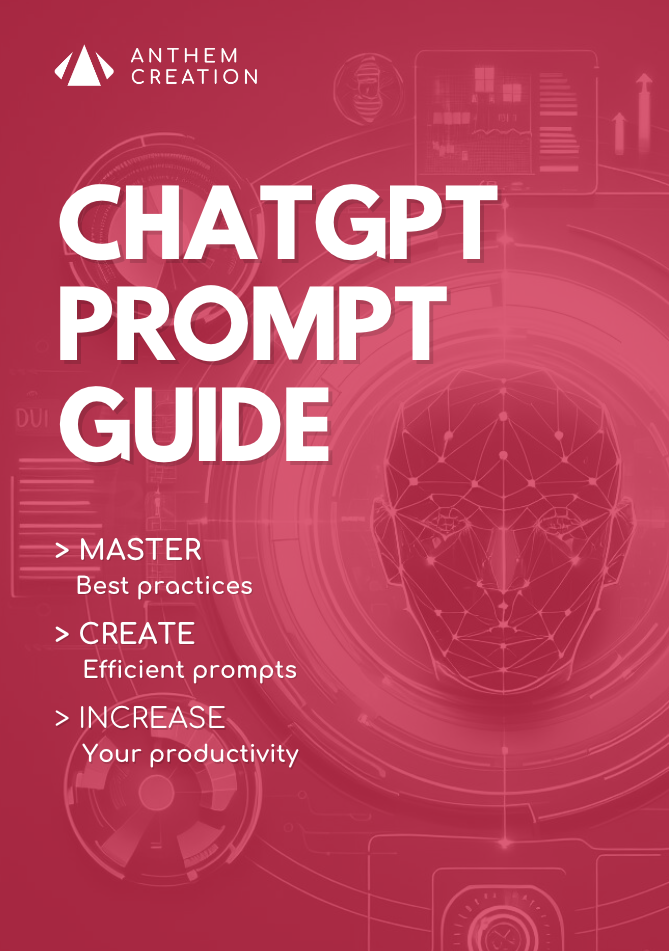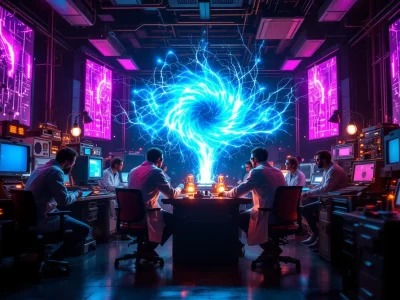Artificial intelligence takes another decisive step forward with the emergence of MCP (Model Context Protocol) servers. This innovative technology developed by Anthropic represents more than just a technical improvement: it fundamentally redefines the way AI models interact with our digital ecosystem.
Until now, AI assistants have remained largely confined to their own environment, limited to their pre-recorded knowledge and unable to dynamically access the data and tools we use every day.

The Model Context Protocol breaks down these barriers by establishingan open standard that allows language models to connect fluidly and securely to practically any external information source or tool.
The MCP architecture: a bridge between AI and our digital tools
The MCP protocol is based on a sophisticated yet efficient architecture, designed to facilitate information exchanges while maintaining a high level of security.
This architecture is built around three main components that work in synergy:
MCP Hosts
The MCP Hosts form the first pillar of this architecture. These are artificial intelligence applications, such as Claude Desktop, which host language models and require access to external resources to enrich their capabilities.
These hosts are the entry points through which users interact with the AI.
MCP Customers
The MCP Clients play the crucial role of secure intermediaries. They establish and maintain connections between AI applications and MCP servers, ensuring that requests and responses are transmitted reliably and securely.
This abstraction layer enables components to be isolated and robust security mechanisms to be implemented.
MCP Servers
Finally, the MCP Servers represent the real innovation of the system. These lightweight but powerful programs expose specific functionality via the standardized protocol.
Each server can provide access to a variety of information sources, whether local (such as your personal files) or distant (such as web APIs), offering AI models an extended view of information.
This architecture communicates primarily via JSON-RPC 2.0, a lightweight communication protocol that enables structured and efficient exchanges between the various components.
The transformative capabilities of MCP servers
MCP servers don’t just open a door to the outside world for AI models – they create a whole ecosystem of interaction.
Concretely, they can expose three types of functionality that radically transform the capabilities of intelligent assistants:
Finding resources
The resources represent the first level of interaction, allowing AI models to access various data sources.
An AI assistant equipped with MCP can thus consult your local documents, query your personal databases, or explore entire collections of information stored on your computer or in the cloud.
This capability is particularly valuable for analyzing proprietary data that the AI could never have known about during its training.
Actuating tools
The tools constitute the active dimension of the MCP system, enabling AI to execute concrete actions in your digital environment.
For example, an MCP server connected to GitHub can authorize an AI assistant to create issues, manage pull requests, or even contribute directly to code repositories.
This capability transforms AI from a simple advisor into an active collaborator capable of performing complex tasks.
Interact
The prompts represent the third pillar of the system, offering reusable templates to guide AI behavior in specific scenarios.
These prompts act as behavioral scripts that enable fine-tuning of the way the assistant interacts with available tools and resources, guaranteeing appropriate, context-sensitive responses.
MCP vs traditional APIs: An architectural innovation
To understand the profound impact of MCP servers, it’s essential to compare them with the traditional APIs that have dominated software integration to date.
This comparison reveals why MCP represents a major architectural breakthrough.
Traditional APIs generally follow a monolithic approach where interactions are rigidly defined and tightly coupled.
Each modification often requires large-scale adjustments, and scaling proves problematic since it means increasing resources for the whole system.
Moreover, their security relies on mechanisms that are often specific to each implementation, creating a heterogeneous landscape that’s difficult to manage consistently.
In contrast, MCP servers fully embrace the modern principles of microservices architecture.
Each MCP server is independent and specialized, providing remarkable flexibility. Services can evolve separately according to their specific needs, and errors remain isolated without contaminating the whole system.
Protocol standardization also ensures consistency in security management, greatly simplifying the governance of access and permissions.
This distributed architecture offers unprecedented interoperability between different AI platforms and models.
It not only facilitates the transition from one provider to another, but also enables the simultaneous integration of multiple AI sources into a unified ecosystem.
Practical applications: When AI becomes an active partner
The practical impact of MCP servers is already manifesting itself in many professional fields, gradually transforming our relationship with artificial intelligence.
For development
In software development, MCPs transform AI assistants into true development collaborators.
An engineer can now ask his assistant to analyze an entire GitHub repository to identify potential vulnerabilities, suggest optimizations based on current project metrics, or even implement certain features directly.
The AI moves from the role of advisor to that of active peer-programmer, capable of interacting with the integrated development environment and version management tools.
For search
For document search and analysis, MCP servers enable AI models to access private or specialized document corpora.
A medical researcher might, for example, ask his assistant to analyze thousands of patient records (while respecting confidentiality standards), identify correlations between treatments and results, and then synthesize this information into structured reports.
AI thus becomes a search assistant capable of processing volumes of information far beyond human capabilities.
To automate
In professional automation, MCPs enable intelligent orchestration of multiple systems.
A manager can entrust his IA assistant with the coordination of complex projects, involving the synchronization of team schedules, the updating of Kanban boards, the generation of progress reports, and even the sending of personalized notifications to the collaborators concerned.
Automation becomes contextual and adaptive, capable of understanding the nuances of complex business situations.
Building your own MCP ecosystem: Tools and methods
The MCP ecosystem is rapidly being enriched with tools and platforms that facilitate the creation of customized AI agents incorporating this technology. Several approaches are possible, depending on your needs and level of technical expertise.
With specialized platforms
Specialized platforms like Google’s Vertex AI Agent Builder or Microsoft’s AutoGen offer a more structured approach.
These environments provide pre-established frameworks for developing sophisticated AI agents capable of interacting with external sources via MCP.
Although still requiring development skills, these platforms dramatically speed up the authoring process by providing pre-built components and intuitive development interfaces.
With n8n
For less technical users, tools like n8n offer a particularly accessible visual approach.
This automation platform lets you graphically create complex workflows incorporating AI models and MCP servers without requiring advanced programming.
For example, a marketing manager could create an agent that automatically monitors mentions of his brand on social networks, analyzes the sentiment expressed using an AI model like GPT-4, and then generates weekly reports emailed to the relevant team.
The creation of AI agents with n8n perfectly illustrates the democratization of MCP technologies. A typical workflow might involve a trigger (such as receiving a message on Telegram), followed by an AI agent node for analysis and response generation, a memory layer to maintain the context of conversations, and finally connectors to various tools such as databases, calendars or CRM systems.
This modular architecture allows you to fine-tune the agent’s behavior to your specific needs.
Read also our article: Creating an AI agent in 2025: Which solutions to explore?
Safety challenges: Necessary vigilance
Despite their considerable advantages, MCP servers introduce security challenges that it would be unwise to ignore. Connecting AI models to external systems inevitably creates new attack surfaces that require special attention.
Theft of authentication tokens represents one of the most serious threats. Attackers who manage to intercept OAuth tokens or other credentials used by MCP servers can potentially gain access to highly sensitive information.
This risk is all the more worrying as MCP servers are often configured to access multiple systems with extended privileges.
Direct compromise of MCP servers is another critical attack vector.
A compromised MCP server can become a gateway to all connected services, creating a particularly dangerous domino effect.
This centralization of access, while advantageous for the legitimate user, becomes problematic in the event of a security breach.
Prompt injection attacks represent a more subtle but equally serious risk. Malicious actors may attempt to manipulate instructions sent to AI models to circumvent ethical safeguards or execute unauthorized actions.
This form of attack exploits the ambiguities of natural language and the limitations of current filtering systems.
Towards a future of contextual and integrated AI
The emergence of MCP servers marks a decisive turning point in the evolution of artificial intelligence. By enabling AI models to interact seamlessly with our digital environment, this technology paves the way for a new generation of truly integrated and contextual assistants.
In the short term, we’re already seeing the emergence of specialized applications that exploit the capabilities of MCP servers for specific use cases.
Search assistants capable of analyzing entire libraries of technical documents, virtual collaborators who actively participate in software development, or automated analysts who synthesize complex data – all these applications are the first concrete manifestations of the transformative potential of this technology.
In the medium term, we can anticipate increasing standardization of the MCP protocol and rapid expansion of the ecosystem of compatible servers.
This evolution should be accompanied by a democratization of AI agent creation tools, making this technology accessible to an ever wider audience. The boundary between specialized developers and knowledgeable users will continue to blur, enabling everyone to create personalized assistants tailored to their specific needs.
In the longer term, MCP servers could catalyze the emergence of a true symbiosis between human and artificial intelligence.
By enabling AI models to access our digital context and act directly on our everyday tools, they create the conditions for fluid collaboration where each intelligence contributes its complementary strengths.
This vision of harmonious man-machine collaboration, long confined to science fiction, is gradually becoming a tangible reality thanks to technical advances such as the MCP protocol.
AI NEWSLETTER
Stay on top of AI with our Newsletter
Every month, AI news and our latest articles, delivered straight to your inbox.

CHATGPT prompt guide (EDITION 2024)
Download our free PDF guide to crafting effective prompts with ChatGPT.
Designed for beginners, it provides you with the knowledge needed to structure your prompts and boost your productivity
With this ebook, you will:
✔ Master Best Practices
Understand how to structure your queries to get clear and precise answers.
✔ Create Effective Prompts
The rules for formulating your questions to receive the best possible responses.
✔ Boost Your Productivity
Simplify your daily tasks by leveraging ChatGPT’s features.
Similar posts
Creating an AI agent in 2025: Which solutions to explore?
The AI agent revolution is in full swing in 2025, offering enthusiasts and professionals alike a multitude of options for building autonomous intelligent assistants. This guide presents an overview of …
OpenAI Operator vs Anthropic Computer Use: The battle of the AI agents
Artificial intelligence continues to revolutionize the way we interact with computers. Two giants stand out in this technological race: OpenAI, with its AI agent named Operator, and Anthropic, with its …
The age of AI agents: the silent revolution of 2025
Soon your computer will anticipate your needs, automatically break down your complex tasks and perform them with near-human intelligence. This is no longer science fiction… it’s the reality of 2025 …


